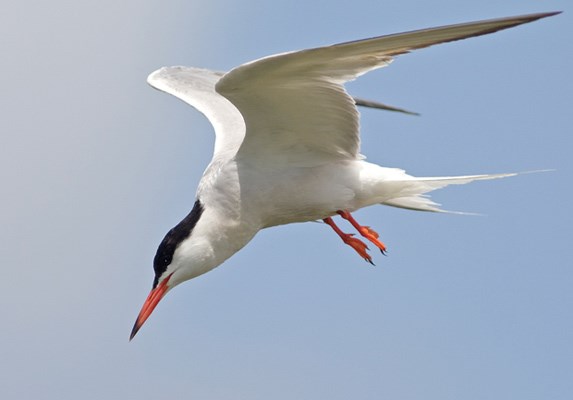VISITORS to the shores of Burrard Inlet, like Maplewood Conservation Area's Osprey Point, enjoy many wonderful sounds like singing eagles, chirping ospreys and the cries of gulls.
All these are so much a part of being near to sea, but suddenly, the air is pierced by shrill notes - some might even call it squawking, by large gulllike birds resting on offshore bars or diving head long plunges into the water: these are Caspian terns.
In early spring, it is possible to see common terns migrating through the area, and very rarely, even an Arctic tern is spotted. And there's a small chance to see black terns, which are commonly seen on freshwater lakes in the Interior.
It is always a good idea to keep an open mind about where birds are seen, because they can fly and rarities turn up with regularity.
The Caspian tern is a large bird sporting a bright orange bill, black cap, and in flight, black wing tips, making it easy to identify. There was a time, not that many years ago, that sightings of Caspian terns were rare, but their numbers are increasing.
Summer birds will have settled in by now, with lots of fledglings about. Some birds, like the red-eyed vireo keep on singing, but when courtship and nesting are over, birds do a lot of calling. Songs and calls (vocalizations) have different purposes from setting up and defending nesting territory to contact calls, ie. keeping in touch ("tweeting") to warn of danger.
Ospreys have been very busy catching fish to feed their hungry young, and also, being ever alert so that an eagle doesn't come in try and steal their catch; as eagles sometimes will do.
From Osprey Point, you can watch busy martins as they swoop into their nest boxes with food for nestlings.
It is often said that martins take a lot of mosquitoes, but apparently this isn't really the case. They do, however; take dragonflies, especially big blue ones, (darners). It is something you can watch for.
If the martins are not at Osprey Point, they're somewhere else like over the pond or salt marsh hunting for food. Martins are joined by swallows like violet-green, tree, barn and cliff. Sometimes, you'll see up high darting about in the air swallowlike birds with more sickle shaped wings - these are swifts. Two species are seen on the North Shore: Vaux's and black. Vaux's nest in tree cavities and the black occupy canyon walls, especially near waterfalls.
Do you like bird's nest soup? It is made from the nest of an oriental swift. It is the bird's saliva which holds the nest together that makes the soup. These are no chimney swifts in B.C. - this ecological role is filled by Vaux's swifts.
Some of the world's fastest flying birds are swifts. Swifts are not related to swallows, but to hummingbirds. Look for swifts on days with low clouds. Folklore has it that when swifts show up in big numbers, fowl weather is sure to follow.
Many birders (like me) enjoy watching butterflies and dragonflies, and Maplewood is a good place to start. Dragonflies with names like darners, dashers, meadow hawks, and jewel wings are so much fun to watch and photograph. Smaller cousins of dragonflies are known as damselflies and are equally beautiful. A good pair of close focusing binoculars and a field guide aid in enjoyment of butterflies and dragonflies.
Find a good flower patch and watch for swallowtails (western and pale), Lorquin's admiral, gray hairstreak, and Milbert's tortoise-shell butterflies.
Al Grass is a naturalist with Wild Bird Trust of British Columbia, which sponsors free walks at Maplewood Flats Conservation Area on the second Saturday of every month. Website: www. wildbirdtrust.org.



